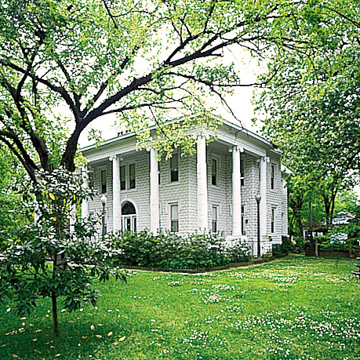This two-and-a-half-story house is built entirely of concrete block. Beginning in 1906 businessman Cavaness used a concrete block molding kit to make the blocks. (A block molding apparatus used during the construction period remains on display on the grounds of the museum.) The house features a massive portico of eight tapered Ionic columns made of concrete blocks across the front. Even the Ionic capitals were of molded concrete. Windows on three of four of the building’s sides are given emphasis by elaborate precast concrete hood molds. In 1965 the house was acquired by the Drew County Historical Society and since then has been operated as a museum. Two log cabins, one dating to 1818 and the other to 1819, are on the grounds.
You are here
Drew County Historical Museum (Pattie and Garvin Cavaness House)
If SAH Archipedia has been useful to you, please consider supporting it.
SAH Archipedia tells the story of the United States through its buildings, landscapes, and cities. This freely available resource empowers the public with authoritative knowledge that deepens their understanding and appreciation of the built environment. But the Society of Architectural Historians, which created SAH Archipedia with University of Virginia Press, needs your support to maintain the high-caliber research, writing, photography, cartography, editing, design, and programming that make SAH Archipedia a trusted online resource available to all who value the history of place, heritage tourism, and learning.













